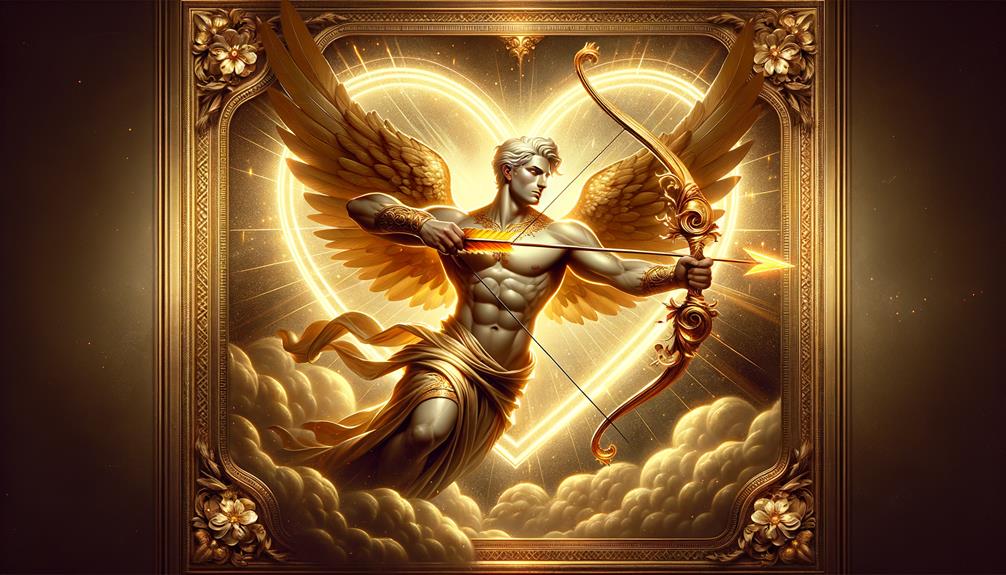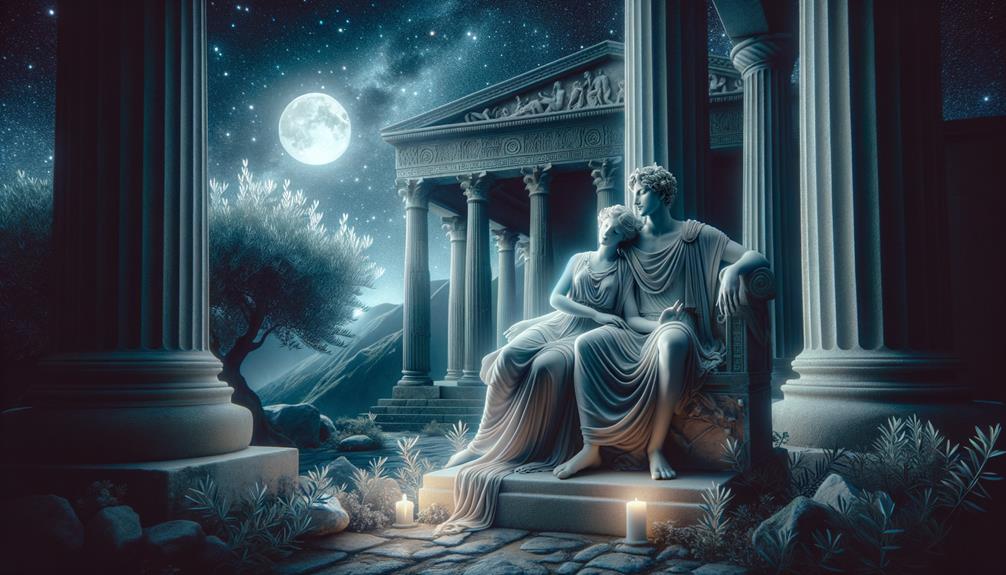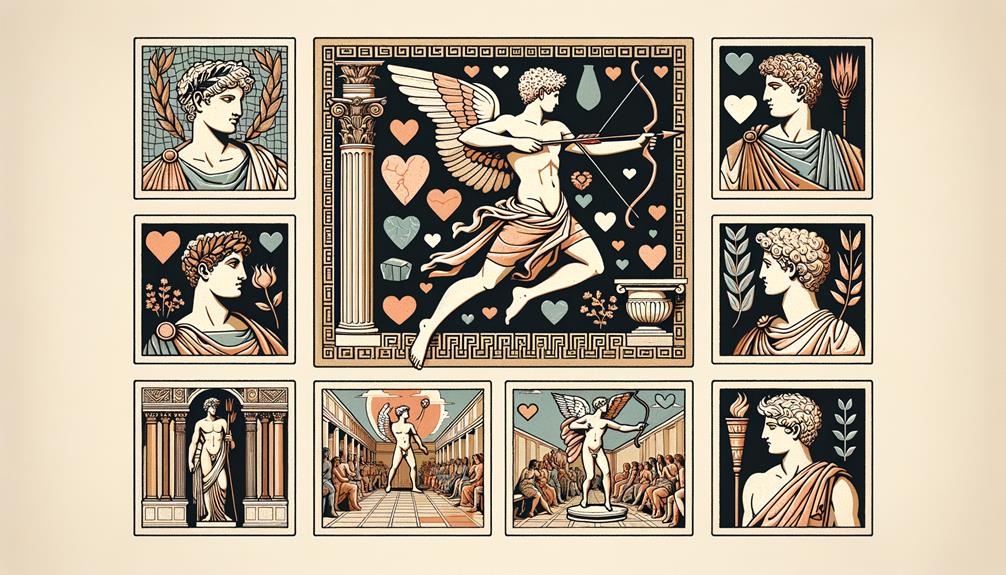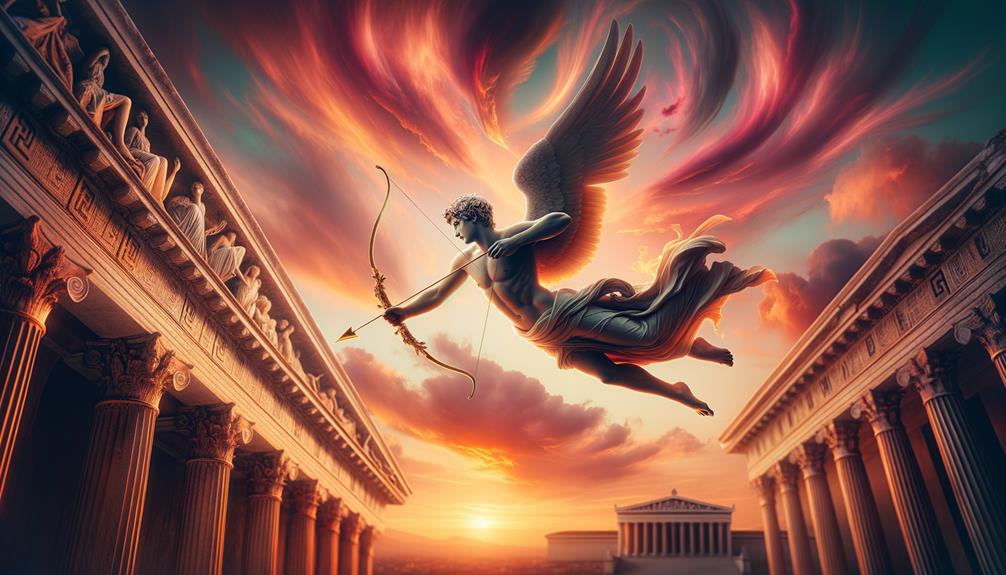Eros, the intriguing god of passion from ancient Greek mythology, is quite a mysterious figure. He's known for symbolizing the irresistible force of attraction and longing. His origin story is shrouded in mystery, with some legends framing him as one of the primordial gods born from Chaos, while others hint at different parentage. Eros was always ready with his famous bow and arrows, stirring up love and hate among both mortals and gods. His mythology is not restricted to these, it also weaves into his captivating yet stormy love affair with Psyche, and his deep ties with religion and culture in ancient Greece. This is just a snapshot of the rich narrative around Eros. As you delve deeper, the intertwining threads of romance, passion, and mythology become even more captivating.
The Birth and Origins of Eros
If we take a closer look at Eros' birth and beginnings, we find conflicting stories in Greek mythology. Some suggest that he is the offspring of Aphrodite, the love goddess, and Ares, the war god. Others claim that he came into being from Chaos, as one of the original gods, symbolizing the irresistible pull of attraction and desire. Eros, being a god, has a far-reaching influence on both mortal beings and fellow gods, directing their fates through the heartbeat of romantic love. His essence, this divine spark, serves as a basic cosmic power, uniting individuals through shared affection and desire. Getting to know Eros isn't just about Greek mythology. It also encourages us to examine the universal principles of attraction and passion that are central to human existence.
Eros: Symbolism and Powers

Let's chat about Eros, the winged Greek god of love, who's usually shown as a young boy armed with a bow and arrows. This iconic imagery isn't just for show, though. It's a symbol of love, desire, and passion that Eros is known for, both in human hearts and among the immortal gods. His golden arrows, for example, are said to stir up affection and desire, while the lead ones supposedly create an aversion to love.
- Eros' bow and arrows: More than simple weapons, these tools have the power to control emotions and change the course of relationships.
- The magic of music: Ever noticed the lyre that's often seen with Eros? That's his way of showing the world the enchanting power of music.
- The sea's role in love: Those dolphins you see with Eros? They symbolize how the sea can influence love.
- The grown-up Eros: This image suggests that love and passion can grow deeper and more profound with time.
All these symbols serve to remind us of the multifaceted nature of love, passion, and the gamut of human emotions.
As we rewrite, we'll keep things simple, stay relevant, avoid cliches, use transition words sparingly, sidestep exaggeration, consider our readers, prefer active voice, and always provide context. This way, our content remains engaging, relatable, and easy to understand.
Love Stories: Eros and Psyche

Eros, the god of love and passion, is best known for his riveting love story with Psyche. This tale is a roller coaster of emotions – it has jealousy, loyalty, and devotion in spades. Psyche, with her entrancing beauty, stirred up Aphrodite's envy, setting off a series of hurdles that Psyche had to overcome to show her love for Eros.
In this captivating tale, Eros conceals his true identity and puts Psyche's trust and loyalty to the test. Their story has its fair share of betrayal and forgiveness, painting a vivid picture of the struggles that often accompany love. Despite the ordeals they had to endure, their love story ends on a high note, with their love becoming immortal, symbolizing the union of soul and desire.
Their love story stands as a testament to love's ability to weather storms and prevail even under the harshest of circumstances. It's a tale that reminds us of the endurance of love and its ability to triumph over adversity.
Eros in Ancient Greek Religion

So, you're curious about Eros, the ancient Greek god of love and passion? He was a pretty big deal back in the day. The Greeks saw him as a god who's been around since the dawn of time, representing love and beauty. Now, here's where it gets interesting. His family tree is a bit of a mystery. Some said he sprung from Chaos, while others claimed he was the offspring of Aphrodite and Ares. This ambiguity made him a fascinating character.
What was he known for, you ask? Well, Eros had quite a bit of sway over passion and fertility. His main worship hub was situated in Thespiae, a city in Boeotia. People turned to him for blessings related to love, desire, and fertility. They even threw a party in his honour called Erotidia.
Eros wasn't just some obscure figure. His myth was deeply interwoven with Greek religion and culture. He embodied the passions that propel human life, making him a crucial part of the spiritual worldview back then.
Artistic Representations of Eros

Eros, the Greek god of love and desire, is quite a popular figure in the world of art. You'd often see him depicted as a winged youngster, armed with a bow and arrows. This image isn't just a random choice by the artist, but rather a symbolic representation of Eros' control over love and desire. It's like a playful nod to his powerful influence, especially when it comes to feelings and relationships.
But artists didn't just stick to one representation of Eros. They mixed things up, depending on how they wanted to portray love and desire. Sometimes, they painted Eros as a mature figure, signifying deep, profound love. Other times, he was shown as a naughty kid, a visual shorthand for raw passion.
In the Hellenistic period, artists started emphasizing Eros' infantile side to underscore his links to fertility. This was a shift from the earlier depictions, and it added a fresh perspective to how people understood the god's influence.
And it wasn't only in paintings that Eros made his mark. He was also a common figure in sculptures and mosaics. The various artistic portrayals of Eros, regardless of the medium, underscored his central role in shaping human emotions and relationships through love and desire. These works of art serve as a testament to the lasting influence of this fascinating god.
Frequently Asked Questions
What Are Some Myths About Eros?
You know, there's a handful of myths floating around about Eros. One of the most famous stories is his love saga with Psyche, where they both had to navigate through a series of challenges for love. Another interesting myth links him to the tale of Persephone's abduction. It was Eros who sparked the flame of love in Hades' heart for her.
What Is the Greek Myth Beloved of Eros?
Eros, the Greek god of love, has an epic tale that people are truly fond of. It's a love story with Psyche, who was a mortal known for her extraordinary beauty. This story is rich with challenges, testing the strength of their love. Interestingly, it also represents the soul's connection with desire. This narrative has always resonated with those who hear it, making it a favourite among tales of Eros.
What Is Eros Passion?
Eros, known for embodying love and longing, is recognized for his fervent and overpowering passion. The arrows he shoots ignite these emotions, moulding relationships and nurturing bonds. This fervour symbolizes the irresistible charm that drives attraction in any relationship.
What Is Eros Myth Symbol?
Eros, a figure from mythology, is often depicted carrying a bow and arrows or a lyre. Sometimes he's shown as a winged youngster, other times as a more mature individual. This is to underscore the nuanced nature of love and the influential role of passion in our relationships.


